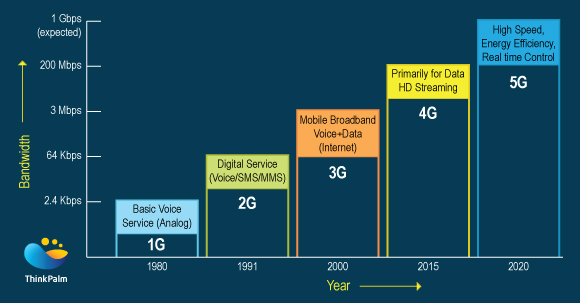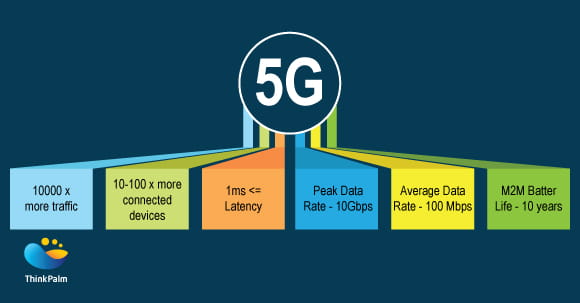Recently we have started reading more about 5G which is considered as an emerging platform allowing growth in many industries. One of the promises offered by 5G is the data transfer rates up to several tens of megabits per second. Other offerings include low latency, improved signal strength with better network coverage. Looking at the history of mobile generations, we can see that a new generation appeared in approximately every ten years. Hence we can expect the arrival of 5G by 2020.
Before moving further onto the details of 5G, let us have a recap of mobile technologies to understand how mobile communication technology has evolved.

In 1876 March 10, Alexander Graham Bell made a telephone call to his assistant saying “Mr. Watson, come here. I want to see you” thereby laying stone for a powerful communication mechanism. Japan being the pioneers in technology innovations, launched the first commercial cellular network in 1979 by NTT. 1G, which was purely analog designed to carry voice alone. There were no SMS/MMS /Internet services in the first generation.
In the early nineties with a transition from analog to digital, where networks transported data via digital signal 2G systems were established. In this generation, SMS/MMS services were introduced. But for internet to surface, we had to wait till the emergence of 3G. 2G offered up to 64 Kbps of speed.
2.5G is a technology between 2G and 3G using 2G system frameworks, introducing packet switching along with circuit switching. It can assist data rate up to 144 kbps. The main 2.5G technologies were GPRS, Enhanced Data Rate for GSM Evolution (EDGE), and Code Division Multiple Access (CDMA) 2000.
By early 2000’s, using Nokia 6630 and subsequent series phones, we had started checking our Emails over phone with 3G. It offered significantly improved uplink and downlink speeds, a higher traffic capacity, and speeds between 200 Kbps up to 3 Mbps.
With the launch of 4G services, the “G- Generation” term is now well known among common man. Compared to others, 4G is advanced with higher data rates. 4G consists of a complete and reliable solution based on IP. Services like voice, data and multimedia are available to users anytime, everywhere and at quite higher data!
As the Internet of Things and cloud based solutions are becoming more popular, it is expected that mobile and wireless traffic volume will increase a thousand-fold over the next decade! The 4G networks will not be substantial enough to support massively connected devices with low latency and significant spectral efficiency.
This urges the need to shift towards a new technology, addressing the challenges that are not effectively addressed by the existing mobile networks. Here’s where 5G becomes significant, addressing higher capacity, higher data rate, lower end-to-end latency, massive device connectivity, reduced cost and consistent Quality of Experience provisioning.
Future networks demand “Everything on Mobile”. Considering connectivity of embedded devices, the numbers of devices on a network generating traffic could rise exponentially. A 5G network is expected to provide up to a million connections per square kilometer.
Latency is the round-trip delay experienced by the user while using the mobile device. Compared to 3G technology, the latency reduced tremendously in 4G. Even then, the delay is still too high for many real time applications. The aim with 5G is to reduce latency to less than 1mS.
The throughput of a 4G network is 10 times higher than that of a 3G network. Upcoming networks are designed to provide advanced services such as virtual and Augmented Reality, Ultra High Definition video conferencing and fast access cloud based services over mobile. This demands a system with high throughput.
As the future networks include sensors and meters requiring a battery life of up to 10 years, 5G network infrastructure and devices will also need to be immensely energy efficient.
5G will need to be flexible enough to efficiently handle a wide range of devices ranging from very simple ones that send only small, rare bursts of data to advanced ones that send large amounts of data quickly.
There are a lot of technology concepts being evolved to address the design considerations for 5G. The main ones include:
A general 5G cellular network architecture [Source: IEEE Access]
With these design considerations, 5G promises to provide

The deployment still seems a long way off and there remains many challenges such as infrastructure demands and spectrum capacity. However, with existing mobile technologies likely unable to meet market demands beyond 2020, 5G is inevitable and let us hope it will create another revolution!!!